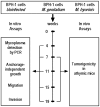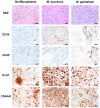Persistent exposure to Mycoplasma induces malignant transformation of human prostate cells
- PMID: 19721714
- PMCID: PMC2730529
- DOI: 10.1371/journal.pone.0006872
Persistent exposure to Mycoplasma induces malignant transformation of human prostate cells
Abstract
Recent epidemiologic, genetic, and molecular studies suggest infection and inflammation initiate certain cancers, including those of the prostate. The American Cancer Society, estimates that approximately 20% of all worldwide cancers are caused by infection. Mycoplasma, a genus of bacteria that lack a cell wall, are among the few prokaryotes that can grow in close relationship with mammalian cells, often without any apparent pathology, for extended periods of time. In this study, the capacity of Mycoplasma genitalium, a prevalent sexually transmitted infection, and Mycoplasma hyorhinis, a mycoplasma found at unusually high frequency among patients with AIDS, to induce a malignant phenotype in benign human prostate cells (BPH-1) was evaluated using a series of in vitro and in vivo assays. After 19 weeks of culture, infected BPH-1 cells achieved anchorage-independent growth and increased migration and invasion. Malignant transformation of infected BPH-1 cells was confirmed by the formation of xenograft tumors in athymic mice. Associated with these changes was an increase in karyotypic entropy, evident by the accumulation of chromosomal aberrations and polysomy. This is the first report describing the capacity of M. genitalium or M. hyorhinis infection to lead to the malignant transformation of benign human epithelial cells and may serve as a model to further study the relationship between prostatitis and prostatic carcinogenesis.
Conflict of interest statement
Figures





Similar articles
-
Detection of antibodies directed at M. hyorhinis p37 in the serum of men with newly diagnosed prostate cancer.BMC Cancer. 2011 Jun 10;11:233. doi: 10.1186/1471-2407-11-233. BMC Cancer. 2011. PMID: 21663671 Free PMC article.
-
Mycoplasma genitalium Infection and Chronic Inflammation in Human Prostate Cancer: Detection Using Prostatectomy and Needle Biopsy Specimens.Cells. 2019 Mar 2;8(3):212. doi: 10.3390/cells8030212. Cells. 2019. PMID: 30832347 Free PMC article.
-
Mycoplasma genitalium and cancer: a brief review.Asian Pac J Cancer Prev. 2013;14(6):3425-8. doi: 10.7314/apjcp.2013.14.6.3425. Asian Pac J Cancer Prev. 2013. PMID: 23886122 Review.
-
Mycoplasmal membrane protein p37 promotes malignant changes in mammalian cells.Can J Microbiol. 2007 Feb;53(2):270-6. doi: 10.1139/W06-120. Can J Microbiol. 2007. PMID: 17496976
-
Mycoplasma genitalium: An emergent sexually transmitted disease?Infect Dis Clin North Am. 2013 Dec;27(4):779-92. doi: 10.1016/j.idc.2013.08.003. Epub 2013 Oct 25. Infect Dis Clin North Am. 2013. PMID: 24275270 Review.
Cited by
-
Glyceraldehyde-3-phosphate dehydrogenase (GAPDH) moonlights as an adhesin in Mycoplasma hyorhinis adhesion to epithelial cells as well as a plasminogen receptor mediating extracellular matrix degradation.Vet Res. 2021 Jun 3;52(1):80. doi: 10.1186/s13567-021-00952-8. Vet Res. 2021. PMID: 34082810 Free PMC article.
-
GFP as a marker for transient gene transfer and expression in Mycoplasma hyorhinis.Springerplus. 2016 Jun 17;5(1):769. doi: 10.1186/s40064-016-2358-3. eCollection 2016. Springerplus. 2016. PMID: 27386255 Free PMC article.
-
Mycoplasma hyorhinis infection promotes gastric cancer cell motility via β-catenin signaling.Cancer Med. 2019 Sep;8(11):5301-5312. doi: 10.1002/cam4.2357. Epub 2019 Jul 18. Cancer Med. 2019. PMID: 31321908 Free PMC article.
-
Mycoplasma hyorhinis infection promotes TNF-α signaling and SMAC mimetic-mediated apoptosis in human prostate cancer.Heliyon. 2023 Oct 11;9(10):e20655. doi: 10.1016/j.heliyon.2023.e20655. eCollection 2023 Oct. Heliyon. 2023. PMID: 37867861 Free PMC article.
-
The Relationship between Mycoplasmas and Cancer: Is It Fact or Fiction ? Narrative Review and Update on the Situation.J Oncol. 2021 Jul 31;2021:9986550. doi: 10.1155/2021/9986550. eCollection 2021. J Oncol. 2021. PMID: 34373693 Free PMC article. Review.
References
-
- book by ASM press “Mycoplasmas: Molecular Biology and Pathogenesis” editors Jack Maniloff, Ronald McElhaney, Lloyd Finch, and Joel Baseman.
-
- Edberg A, Jurstrand M, Johansson E, Wikander E, Höög A, et al. A comparative study of three different PCR assays for detection of Mycoplasma genitalium in urogenital specimens from men and women. J Med Microbiol. 2008;57:304–9. - PubMed
-
- Taylor-Robinson D, Horner P. Mycoplasma genitalium and asymptomatic chlamydia-negative non-gonococcal urethritis revisited. Int J STD AIDS. 2005;16:768–9. - PubMed
Publication types
MeSH terms
LinkOut - more resources
Full Text Sources
Other Literature Sources
Medical

